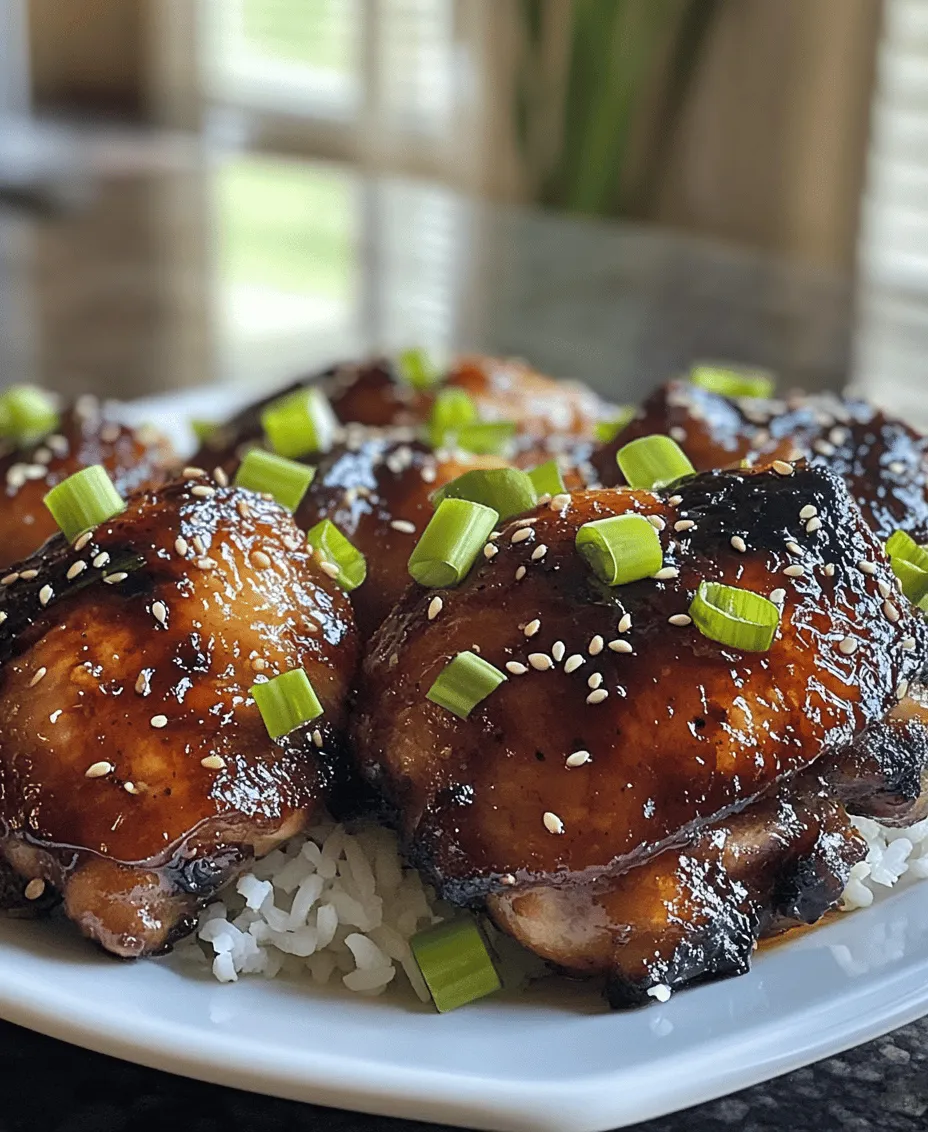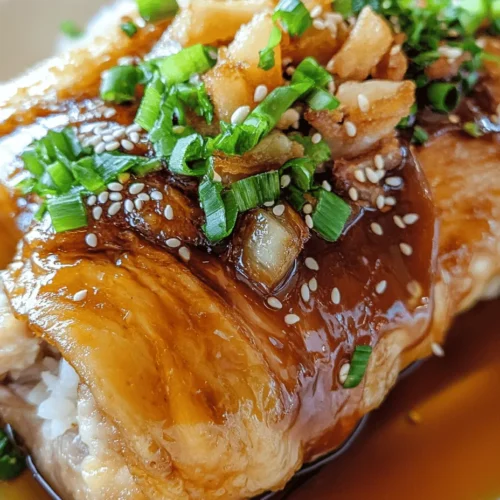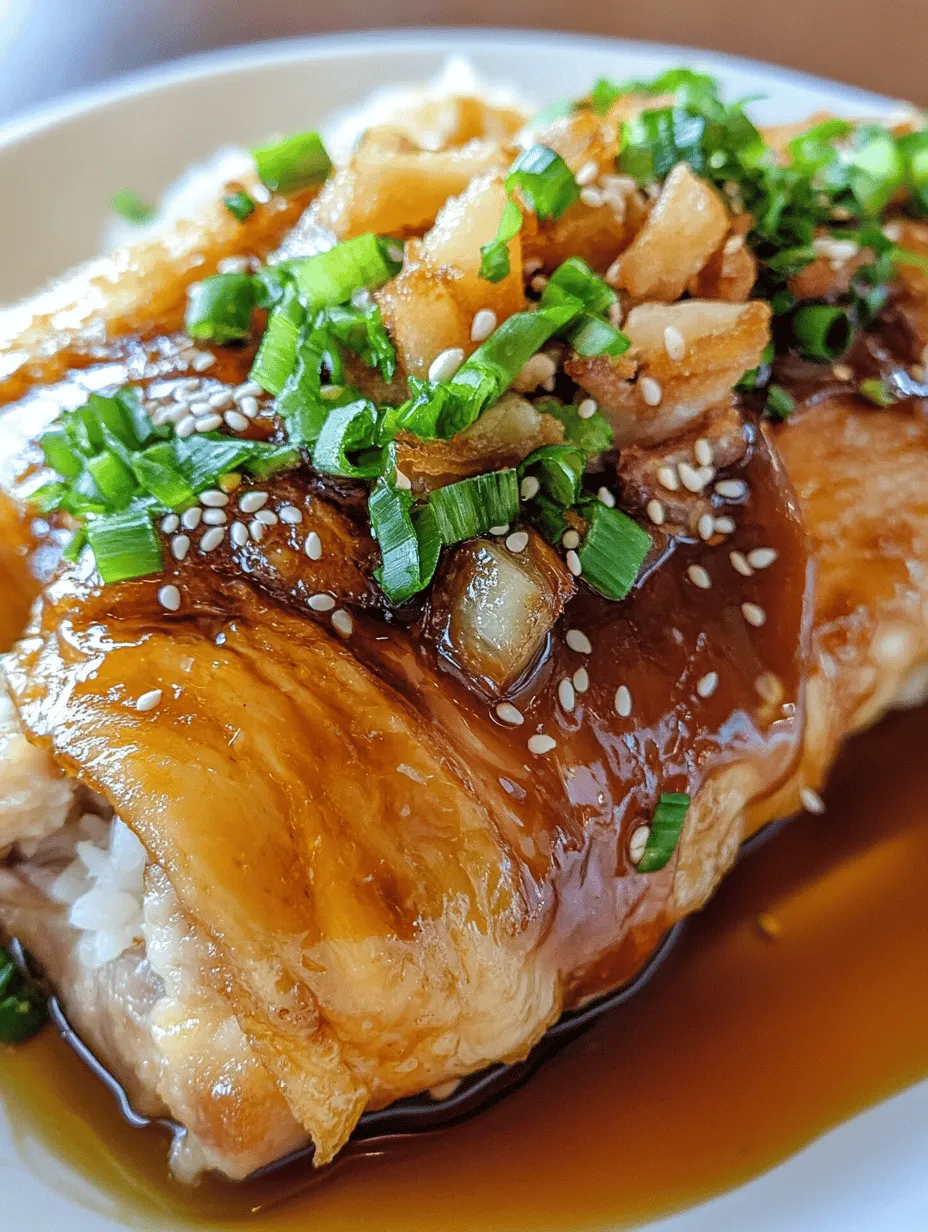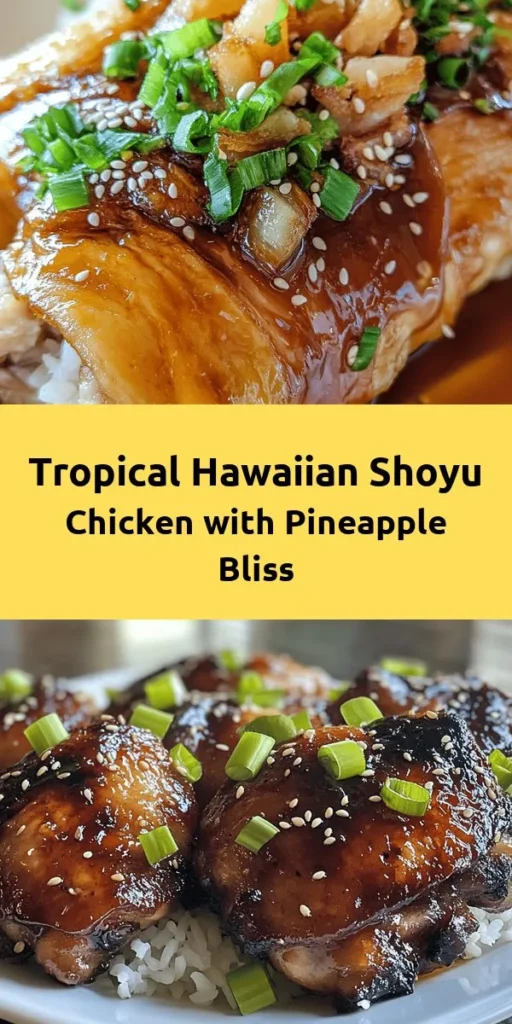Introduction
Hawaiian cuisine is a vibrant tapestry woven from the island’s rich cultural history, showcasing influences from Polynesia, Asia, and beyond. The islands are renowned not only for their stunning landscapes but also for their diverse culinary offerings, each dish telling a story that reflects the melting pot of cultures that have settled in Hawaii. One such dish that embodies the essence of Hawaiian cooking is Shoyu Chicken, a beloved staple in households across the islands.
Shoyu Chicken is more than just a meal; it’s a celebration of flavor that harmoniously blends savory, sweet, and tangy notes. The dish is characterized by its tender chicken, marinated in a mixture of soy sauce, pineapple juice, brown sugar, garlic, and ginger, creating a symphony of tastes that transport you straight to the beaches of Hawaii with each delicious bite. This recipe is not only easy to follow but also offers a comforting familiarity that appeals to locals and visitors alike.
In this article, we will delve into the world of Hawaiian Shoyu Chicken, providing you with a detailed, easy-to-follow recipe that captures the spirit of the islands. Whether you’re looking to impress guests at your next gathering or simply craving a taste of Hawaii at home, this dish is sure to satisfy. Let’s embark on this culinary journey and discover the magic of Shoyu Chicken.
Understanding Shoyu Chicken
Origins and History of Shoyu Chicken in Hawaiian Culture
Shoyu Chicken has its roots deeply embedded in the history of Hawaii, where the fusion of culinary traditions has led to the creation of unique and flavorful dishes. The term “shoyu” refers to soy sauce in Japanese, a key ingredient that has found its way into many Hawaiian recipes due to the significant Japanese influence on the islands. Japanese immigrants brought with them their love for soy sauce, which soon became a staple in Hawaiian kitchens.
Over the years, Shoyu Chicken has evolved, incorporating local ingredients and flavors that make it distinctly Hawaiian. It is often served at family gatherings, luaus, and potlucks, embodying the spirit of ‘ohana (family) and togetherness. This dish is not only a testament to the culinary diversity of Hawaii but also represents the warmth and hospitality of its people.
The Role of Soy Sauce (Shoyu) in Hawaiian Cooking
Soy sauce, particularly shoyu, plays a pivotal role in Hawaiian cuisine, serving as a marinade, seasoning, and flavor enhancer in various dishes. Unlike regular soy sauce, which can be quite salty, shoyu is typically sweeter and milder, making it ideal for Hawaiian recipes. This versatility allows shoyu to complement a wide range of ingredients, from meats to vegetables, enhancing their natural flavors without overpowering them.
In Shoyu Chicken, the combination of shoyu with other ingredients creates a balanced marinade that infuses the chicken with a delightful umami flavor. This balance is essential in achieving the signature taste of the dish, making it a favorite among locals and visitors alike.
Importance of Using Fresh Ingredients
One of the keys to unlocking the full potential of Shoyu Chicken is the use of fresh ingredients. Freshness not only enhances the flavor profile of the dish but also elevates its overall quality. For instance, using fresh pineapple juice adds a vibrant sweetness and acidity that pairs beautifully with the saltiness of the shoyu. Similarly, fresh garlic and ginger contribute aromatic qualities that make the dish irresistible.
When preparing Shoyu Chicken, it is essential to select high-quality ingredients to ensure the best flavor and texture. Opting for fresh, locally sourced produce whenever possible not only supports local farmers but also brings the authentic taste of Hawaii into your kitchen.
Ingredients Breakdown
To prepare Hawaiian Shoyu Chicken, you will need the following ingredients:
Chicken Thighs
Using bone-in, skin-on chicken thighs is highly recommended for this recipe. The bone adds richness and moisture, while the skin helps to retain flavor during cooking. Chicken thighs are inherently juicier and more forgiving than chicken breasts, making them the ideal choice for this dish. The marbling of fat in the thighs allows for a tender and succulent result, ensuring that each bite is packed with flavor.
Soy Sauce
As the star ingredient, soy sauce is what gives Shoyu Chicken its signature taste. When selecting soy sauce for this recipe, it’s essential to use shoyu, which is a Japanese-style soy sauce that is sweeter and less salty than its Chinese counterpart. This unique flavor profile enhances the dish, allowing for a perfect balance with the other ingredients.
Pineapple Juice
The addition of pineapple juice is what elevates the Shoyu Chicken to a new level of deliciousness. The sweet and tangy flavor of fresh pineapple juice not only complements the savory notes of the soy sauce but also helps to tenderize the chicken. When preparing your marinade, opt for 100% pure pineapple juice without added sugars or preservatives for the best results.
Brown Sugar
Brown sugar plays a crucial role in balancing the saltiness of the soy sauce. Its natural molasses content provides a depth of flavor and a subtle sweetness that enhances the overall taste of the dish. The caramelization of the brown sugar during cooking also contributes to a beautiful glaze, giving the chicken a mouthwatering appearance.
Garlic and Ginger
These two aromatic ingredients are essential for bringing depth and complexity to the dish. Fresh garlic adds a pungent, savory note, while ginger provides warmth and a hint of spice. Together, they create a fragrant base that elevates the flavor profile of the Shoyu Chicken, making it truly irresistible.
Sesame Oil
A splash of sesame oil adds a nutty richness to the marinade, enhancing the overall flavor of the dish. This ingredient is particularly important in Asian cuisines, and its use in Shoyu Chicken pays homage to those culinary traditions. A little goes a long way, so just a teaspoon will suffice to achieve the desired flavor without overpowering the other ingredients.
Garnishes
To elevate your Shoyu Chicken presentation, consider garnishing with sliced green onions and toasted sesame seeds. These garnishes not only add visual appeal but also provide a fresh crunch that complements the tender chicken. Additionally, they enhance the dish’s flavor profile, making each bite a delightful experience.
Serving Suggestion
Hawaiian Shoyu Chicken pairs beautifully with a side of fluffy cooked rice, which helps soak up the delicious marinade. You can also serve it alongside steamed vegetables or a fresh salad to create a balanced meal. The combination of flavors and textures will transport you to the islands, making every bite a taste of aloha.
Marinating Process
Now that we have covered the essential ingredients, it’s time to discuss the marinating process, which is critical for infusing the chicken with flavor and ensuring tenderness.
1. Prepare the Marinade: In a large bowl or mixing container, combine the shoyu, pineapple juice, brown sugar, minced garlic, grated ginger, and sesame oil. Whisk the ingredients together until the brown sugar is fully dissolved, creating a harmonious marinade that blends all the flavors together.
2. Marinate the Chicken: Place the chicken thighs into a resealable plastic bag or a shallow dish. Pour the marinade over the chicken, ensuring each piece is well-coated. Seal the bag tightly, removing any excess air, or cover the dish with plastic wrap. Refrigerate for at least 1-2 hours, but for best results, marinate overnight. This extended marinating time allows the chicken to absorb the flavors fully, resulting in a more delicious and aromatic dish.
3. Prepare for Cooking: When you’re ready to cook, remove the chicken from the marinade and let it come to room temperature for about 15-20 minutes. This step ensures even cooking. You can reserve some of the marinade for glazing the chicken while it cooks, but be sure to bring it to a boil for a few minutes first to eliminate any harmful bacteria from the raw chicken.
Stay tuned for the subsequent steps in preparing and cooking your Hawaiian Shoyu Chicken, where we will guide you through the cooking methods that yield the best results. With each step, you’ll be one step closer to enjoying the delectable flavors of this beloved Hawaiian dish.

Importance of Marinating Chicken for Maximum Flavor
Marinating is an essential step in preparing Hawaiian Shoyu Chicken, as it allows the flavors to permeate the meat, resulting in a dish that is both tender and packed with taste. The marinade not only enhances the flavor but also helps to tenderize the chicken, ensuring that each bite is juicy and succulent. In this recipe, the combination of soy sauce, ginger, garlic, and pineapple juice creates a unique flavor profile that is distinctly Hawaiian, transforming simple chicken into a delectable dish.
Step-by-Step Guide on How to Prepare the Marinade
To create the perfect marinade for your Hawaiian Shoyu Chicken, follow these simple steps:
1. Gather Your Ingredients: You will need:
– 1 cup soy sauce
– 1 cup pineapple juice (freshly squeezed or canned)
– 1 tablespoon minced garlic
– 1 tablespoon grated fresh ginger
– 1 tablespoon brown sugar (adjust to taste)
– 1 teaspoon sesame oil
– Optional: chopped green onions for garnish
2. Mix the Ingredients: In a medium-sized bowl, combine the soy sauce, pineapple juice, minced garlic, grated ginger, brown sugar, and sesame oil. Whisk until the sugar is fully dissolved and the ingredients are well blended.
3. Taste and Adjust: It’s important to taste your marinade. Depending on your preference for sweetness or saltiness, you can adjust the amount of brown sugar or soy sauce accordingly.
4. Marinate the Chicken: Place your chicken pieces in a large resealable plastic bag or a shallow dish. Pour the marinade over the chicken, ensuring each piece is well coated. Seal the bag or cover the dish, and refrigerate.
Recommended Marinating Time for Optimal Flavor Absorption
For the best results, allow the chicken to marinate for at least 2 hours, though overnight is ideal. The longer the chicken sits in the marinade, the more flavor it will absorb. However, be cautious not to exceed 24 hours, as the acidity from the pineapple juice can start to break down the meat too much, leading to a mushy texture.
Cooking Instructions
Once your chicken has marinated to perfection, it’s time to cook it. Follow these detailed steps to ensure your Hawaiian Shoyu Chicken turns out deliciously.
Preheating the Oven: Why the Right Temperature Matters
Preheat your oven to 375°F (190°C). The right temperature is crucial for ensuring that the chicken cooks evenly while allowing the skin to crisp up nicely. An oven that is too hot can lead to burnt skin and undercooked meat, while an oven that is too cool will result in dry chicken.
Searing Chicken: Techniques for Achieving Crispy Skin
While you can bake the chicken directly after marinating, searing it first can enhance flavor and texture. Here’s how to do it:
1. Heat a Large Skillet: Place a large oven-safe skillet over medium-high heat and add a tablespoon of oil (vegetable or canola oil works best).
2. Sear the Chicken: Once the oil is hot, remove the chicken from the marinade (reserve the marinade for later) and place it in the skillet, skin-side down. Sear for about 4-5 minutes, or until the skin is golden brown and crispy. Flip the chicken and sear the other side for an additional 2-3 minutes.
3. Transfer to the Oven: After searing, transfer the skillet to the preheated oven to finish cooking. This method not only seals in the juices but also gives your chicken a beautiful, crispy skin.
Managing the Sauce: Tips for Boiling and Simmering
While the chicken is baking, you can prepare the sauce. Here’s how:
1. Use the Reserved Marinade: Pour the reserved marinade into a small saucepan. Bring it to a boil over medium heat, then reduce to a simmer. This will cook the marinade and eliminate any raw chicken contaminants.
2. Thicken the Sauce (Optional): If you prefer a thicker sauce, mix 1 tablespoon of cornstarch with 2 tablespoons of cold water to create a slurry. Add this to the simmering sauce and stir until it thickens.
Explanation of the Baking Process and Ensuring Proper Doneness
Bake the chicken in the oven for about 25-30 minutes, or until the internal temperature reaches 165°F (74°C). It’s important to use a meat thermometer to ensure that your chicken is cooked thoroughly without drying it out. If the skin starts to brown too much before the chicken is cooked through, cover it loosely with aluminum foil.
Serving Suggestions
Hawaiian Shoyu Chicken is not only flavorful but also versatile in terms of presentation and accompaniments.
Ideas for Plating Hawaiian Shoyu Chicken
When serving, arrange the chicken pieces on a large platter, drizzling the thickened sauce over the top. Garnish with chopped green onions or sesame seeds for a pop of color. You can also serve it with pineapple slices or wedges for a fresh, tropical touch.
Complementary Side Dishes That Pair Well with the Chicken
To round out your meal, consider serving Hawaiian Shoyu Chicken with some of these delicious side dishes:
– Steamed Rice: A classic pairing, white or brown rice soaks up the flavorful sauce beautifully.
– Fried Rice: For a twist, serve it with fried rice packed with vegetables and a hint of soy sauce.
– Grilled Vegetables: Seasonal vegetables such as bell peppers, zucchini, and asparagus can be lightly grilled or roasted.
– Hawaiian Mac Salad: This creamy pasta salad is a staple in Hawaiian cuisine and complements the chicken’s flavors wonderfully.
Creative Variations: How to Customize the Dish to Personal Taste
Feel free to experiment with this recipe by adding your twist:
– Spicy Kick: Incorporate sliced jalapeños or a dash of hot sauce into the marinade for a spicy version.
– Different Proteins: While chicken is traditional, you can substitute with pork or tofu for a vegetarian option.
– Add More Fruit: Include diced mango or papaya in the marinade for additional sweetness and tropical flair.
Nutritional Information
Understanding the nutritional profile of Hawaiian Shoyu Chicken helps in meal planning and portion control.
Overview of the Nutritional Benefits of the Main Ingredients
– Chicken: A great source of lean protein, which is essential for muscle growth and repair.
– Soy Sauce: Adds flavor with low calories but is high in sodium; consider using low-sodium soy sauce for a healthier option.
– Pineapple Juice: Rich in vitamin C and bromelain, which can aid digestion and reduce inflammation.
– Ginger: Known for its anti-inflammatory properties and digestive benefits.
Discussion on Portion Sizes and Potential Health Considerations
A typical serving size of Hawaiian Shoyu Chicken is approximately 4-6 ounces, providing a balanced portion of protein. However, be mindful of the sodium content in soy sauce, especially if you are watching your salt intake. Pairing the chicken with fiber-rich vegetables and whole grains can create a well-rounded meal.
Caloric Breakdown of the Dish Per Serving
On average, one serving of Hawaiian Shoyu Chicken contains about 300-350 calories, depending on the portion size and additional ingredients. To maintain a healthy caloric intake, consider adjusting the serving size or pairing it with lighter side dishes.
Conclusion
Hawaiian Shoyu Chicken is more than just a meal; it’s a celebration of flavors and a nod to the rich culinary traditions of Hawaii. The combination of savory and sweet elements, along with the tender, juicy chicken, creates a dish that is sure to impress family and friends alike.
We encourage you to try this recipe for yourself and experience the delightful taste of Hawaii in your own kitchen. Whether you’re gathering for a family dinner or hosting a backyard barbecue, this dish is perfect for sharing and creating lasting memories. Cooking is a joy, especially when you can bring people together over a delicious homemade meal. Enjoy the journey of making Hawaiian Shoyu Chicken and savor every bite!



